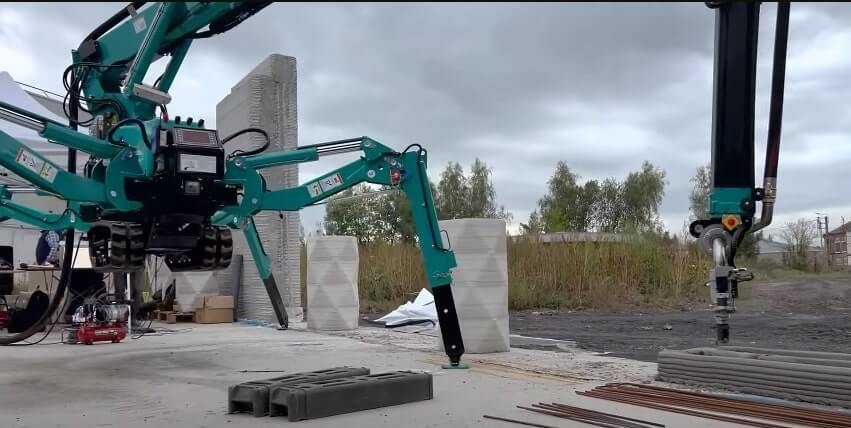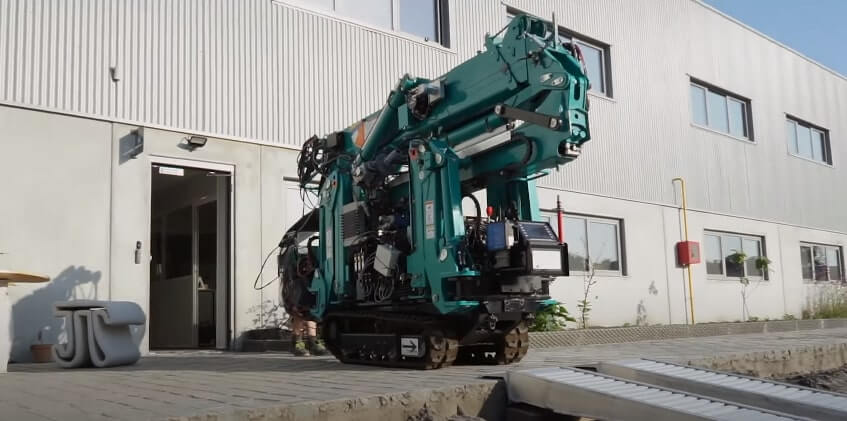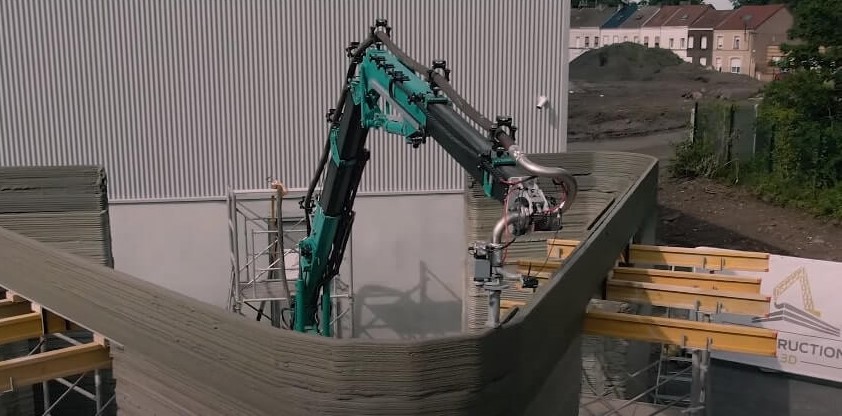As an Amazon Associate I earn from qualifying purchases.
Are you considering venturing into the innovative world of concrete 3D printing but find yourself pondering the crucial question – “How much does a concrete 3D printer cost?” As technology continues to redefine the construction landscape, the allure of 3D printing for concrete structures has garnered widespread attention. In this exploration of costs, we unveil the intricacies associated with acquiring a concrete 3D printer, shedding light on key factors that influence pricing. From cutting-edge features to the latest advancements, understanding the investment required is paramount. Join us on this insightful journey to uncover the financial considerations of embracing concrete 3D printing technology.
The Basics of Concrete 3D Printers

Embarking on the journey of understanding concrete 3D printers unveils a realm where innovation converges with construction. In this exploration, we’ll unravel the basics of concrete 3D printing, from the fascinating technology behind it to the diverse types of printers available, and we’ll weigh the advantages and limitations that come with this revolutionary approach.
A. Explanation of Concrete 3D Printing Technology
Concrete 3D printing is a groundbreaking technology that has reshaped the construction landscape. At its core, it involves the layer-by-layer deposition of concrete material to create three-dimensional structures. This process, often referred to as additive manufacturing, allows for intricate designs and customized construction projects.
The technology employs a unique blend of concrete mixtures optimized for 3D printing, ensuring structural integrity and durability. Layer upon layer, the printer follows a digital blueprint, bringing architectural visions to life with unprecedented precision.
B. Types of Concrete 3D Printers
1. Extrusion-Based Printers
Extrusion-based concrete 3D printers function much like traditional Fused Deposition Modeling (FDM) printers but on a larger scale. These printers use a nozzle to extrude a continuous flow of concrete material, creating the desired structure layer by layer. Extrusion-based printers are known for their efficiency and suitability for larger-scale projects.
2. Powder Bed Printers
In contrast, powder bed concrete 3D printers utilize a bed of powdered material, often a cement mixture. A binder, selectively applied according to the digital design, solidifies the powder, forming the object layer by layer. This approach offers high precision and is particularly well-suited for intricate architectural elements.
C. Advantages and Limitations of Concrete 3D Printing Advantages:
Concrete 3D printing brings forth a myriad of benefits. It significantly reduces construction time, minimizes material waste, and makes it possible to create intricate structures that would be difficult to create with typical methods. Additionally, the ability to customize designs with precision opens doors to unprecedented architectural possibilities.
Limitations:
While the technology holds immense promise, it is not without its challenges. Limitations include the need for specialized knowledge in operation, the cost of equipment and materials, and considerations regarding structural certification. As the industry continues to evolve, ongoing research and development aim to address these limitations and unlock the full potential of concrete 3D printing.
Factors Influencing Concrete 3D Printer Costs

Exploring the intricate world of concrete 3D printing unveils a realm where innovation meets construction, and at the heart of this technological marvel lies the pressing question: What factors influence the costs of concrete 3D printers? Delving into this query requires a comprehensive examination of key elements that contribute to the price tag associated with these cutting-edge machines.
A. Printer Size and Build Volume
One of the foremost factors influencing the cost of a concrete 3D printer is its size and build volume. Larger printers capable of accommodating substantial construction projects often come with a higher price point. The expansive build volume not only enhances versatility but also caters to the demands of ambitious architectural endeavors.
B. Printing Speed and Efficiency
In the realm of 3D printing, time is money, and the speed and efficiency of a concrete 3D printer directly impacts its cost. High-speed printers equipped with advanced technology may command a premium, offering the advantage of quicker project turnaround without compromising on precision.
C. Printing Resolution and Quality
For those seeking impeccable detail and superior quality in their printed structures, the printing resolution and overall output quality become pivotal considerations. Higher resolution capabilities often translate to a more refined end product, but this enhanced precision can also contribute to a higher upfront cost.
D. Material Compatibility
The type of materials a concrete 3D printer can work with significantly influences its cost. Printers designed to handle a diverse range of construction-grade materials may be more expensive due to the engineering required to ensure compatibility and reliability across various substances.
E. Automation and Features
Automation and additional features contribute to the overall user experience and, consequently, the price of a concrete 3D printer. Features such as self-leveling platforms, automated calibration, and intuitive user interfaces streamline the printing process but may add to the initial investment.
In the dynamic landscape of concrete 3D printing, understanding these nuanced factors empowers decision-makers to make informed choices aligning with their project requirements and budget constraints. As technology advances, the interplay of these elements continues to shape the evolving cost landscape of concrete 3D printers, ushering in a new era of construction possibilities.
Challenges in Cost Estimation

Unveiling the financial anatomy of concrete 3D printers, let’s navigate through the intricacies of a comprehensive cost breakdown. Beyond the apparent upfront expense, understanding the nuanced components is key to making informed decisions in the world of cutting-edge construction technology.
A. Printer Hardware Costs
At the foundation of the cost breakdown lies the tangible machinery – the heart and soul of the concrete 3D printer. Components such as the robust frame, precision-driven extrusion system, and efficient motors constitute the hardware costs. The quality and capabilities of these elements not only dictate the initial investment but also play a vital role in determining the printer’s longevity and performance.
B. Software and Licensing Fees
Empowering the hardware is the software ecosystem, a crucial facet often overlooked. Slicing software, user interfaces, and firmware updates contribute significantly to the printer’s functionality. Licensing fees for proprietary software or premium features can add to the overall cost but are instrumental in optimizing the printer’s capabilities and ensuring seamless operation.
C. Maintenance and Upkeep Expenses
Ensuring the longevity and reliability of a concrete 3D printer involves ongoing maintenance and upkeep. Regular check-ups, replacement of worn-out components, and firmware updates fall under this category. While these expenses may seem incremental, they are vital for sustaining peak performance and avoiding costly downtimes.
D. Consumables and Materials
Beyond the initial investment, consider the ongoing expense of consumables and materials. The type of construction-grade materials used, along with the volume of printing, directly influences recurring costs. A comprehensive cost breakdown takes into account the consumables, including filaments and support materials, ensuring a realistic projection of the total cost of ownership.
Navigating the complex landscape of concrete 3D printer costs involves a meticulous examination of these components. As you embark on this technological venture, understanding the interplay of hardware, software, maintenance, and materials is not only an investment in the printer itself but a strategic move towards sustainable, efficient, and cost-effective construction practices.
Frequently Asked Questions (FAQs)
Take a look at the commonly asked questions listed below to learn more about cutting-edge building technologies.
When investing in a concrete 3D printer, key features such as printer size, printing speed, resolution, material compatibility, and additional automation features should be carefully evaluated to align with your specific project requirements.
The size of a concrete 3D printer significantly influences its cost. Take a look at the commonly asked questions listed below to learn more about cutting-edge building technologies.
Yes, owning a concrete 3D printer entails ongoing expenses, including maintenance, consumables, and material costs. Comprehending these variables is essential for long-term planning and budgeting.
Concrete 3D printers can work with various construction-grade materials, including concrete mixes, mortars, and specialized additives. Compatibility depends on the printer’s design and specifications.
Absolutely. Concrete 3D printing technology is versatile and can be employed for residential construction projects, offering efficiency and cost-effectiveness in building structures.
Some governments provide incentives or grants to encourage the adoption of innovative construction technologies, including concrete 3D printing. Research local policies to explore potential financial support.
The lifespan of a concrete 3D printer varies based on factors such as build quality, maintenance, and technological advancements. On average, a well-maintained printer can last several years.
Explore these FAQs to navigate the complexities of concrete 3D printing, empowering your decision-making process in adopting this transformative construction technology.
Conclusion
Investing in a concrete 3D printer involves careful consideration. Key factors include evaluating critical features, understanding the impact of size on cost, factoring in ongoing expenses, and exploring material compatibility. Recognizing the versatility of residential construction, checking for government incentives, and weighing DIY vs. pre-assembled options are crucial.
Ultimately, this investment signifies a move towards efficient, sustainable construction. Consider long-term benefits, environmental impacts, and leasing alternatives. Your choices shape the future of construction, contributing to a more sustainable and innovative industry. Investing in a concrete 3D printer isn’t just a financial decision; it’s a commitment to progress and responsible construction practices. May your journey be guided by informed choices and a vision for a sustainable future.
Related Guide
How to Make Money with a 3D Printer?
How Much Does It Cost to Run a 3D Printer?
Amazon and the Amazon logo are trademarks of Amazon.com, Inc, or its affiliates.
Leave a Reply